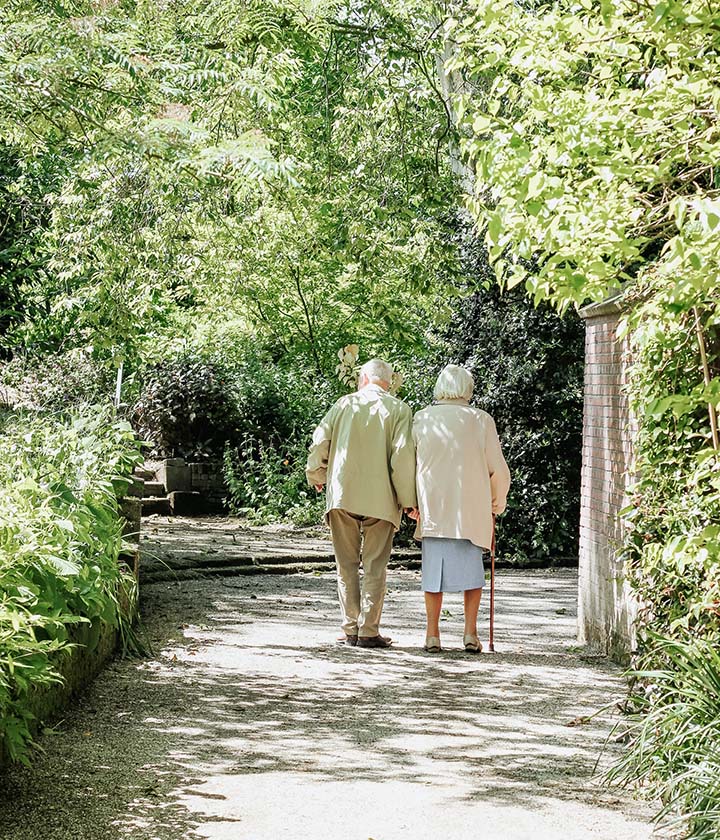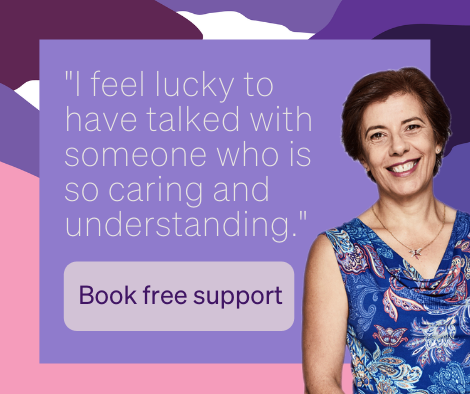In our experience, the ‘inner circle’ who care for the seriously ill or frail person – which may include partners, parents, sons and daughters and other people who matter the most – are crucial when it comes to ‘doing’ the last stages of life well.
These are the people who will be responsible for making important decisions about care as the person’s health steadily declines. When those in the inner circle are well informed, well prepared and well supported by the ‘outer circle’ of care (GP, health and community services, palliative care, Violet guides, etc.), they can make better decisions not only for the person they’re caring for but also for the people around them.
The importance of choice
It’s not uncommon to not know what options there are when caring for someone in the last stages of life. Most people will end up in hospital as a result – sometimes with unwanted or unnecessary medical intervention – even though this may not be what they planned for.
If information about your choices is not readily available or your questions go unanswered, it can be difficult to make decisions that are best for you and the person you are caring for. These may include whether your loved can be cared for at home; what you as the person caring needs to do (regarding work, family, self-care, etc.) to make that possible; how you access services to help you; the importance of palliative care; what options exist beyond in-home care – the role of hospital, hospice and residential aged care and whether these are right for your loved one and family; and what happens after the person is gone.
Knowing what your choices are can give you more control over your loved one’s last stages of life. Ultimately, it can change the experience for you, your family and the person you are caring for – whether you look back on this momentous event as ‘good’ or ‘bad’. It is important to remember that this is your journey, too. While it is different to the one experienced by the person you are caring for, it will live with you and your family for the rest of your lives.
From hospital to home
Coming home after a hospital admission, or deciding not to continue inpatient treatment, can be a relief but also a little daunting, with changes and adjustments often to be made. Be sure to ask the hospital staff about discharge planning as soon as mention is made of the patient returning home. This vital step in the process can sometimes be missed, along with important discussions about what the patient and their family would like, what is possible in terms of care and how to facilitate that.
The aim of discharge planning is to ensure a safe and smooth transition from hospital for those who wish to return home and who still need care and support. To ensure their needs will be met once they are back home, planning should always involve the patient, the people caring for them, family and any professional staff involved in the person’s care. Typically, this will involve a multidisciplinary team made up of medical, nursing and allied health staff (such as a physiotherapist, occupational therapist, pharmacist or social worker).
Doing what’s right for you
While there are commonalities when caring for someone in the last stages of life, it is not a one-size-fits-all proposition. Every family has different needs and their own ways of doing things. What may suit some people may not suit others.
First, talk to the person to find out what their wishes are; whether they would like to be cared for at home, in a hospice, aged-care facility or hospital, for example. Then consider what you might need (information, tools, services, support people) to make that happen and who is available to help (family, friends, neighbours, etc.). Having these conversations early on will:
- eliminate any uncertainty you may feel about what the person you are caring for would like;
- allow you to plan and prepare for the months, weeks and days ahead;
- enable you to make decisions that lead to a better caring experience; and
- help you fulfil the person’s final wishes.
When making decisions, try not to put too much pressure on yourself. It’s okay if your loved one chooses not to be cared for at home, if you are not willing or able to care for them in your own home or are concerned about being in a house where someone has died. Regardless of where they spend their final months, weeks and days, you can still make it a meaningful and special experience – one where the person is comfortable and has dignity.
Be sure to communicate what’s important to you and the person you are caring for: what you both want or don’t want. Research your options. Don’t be afraid to ask questions or seek clarification about anything you’re unsure of or don’t understand. You might find it helpful to talk to someone who has experience of caring for a person in the last stages of life, such as your GP, local palliative care service or a Violet guide. You can also contact one of the many health, community and government services for assistance with coordinating care.
What are your options?
Choosing where and how to experience the last stages of life is a very personal decision and may depend on a range of factors such as your loved one’s final wishes, their physical health and mental fitness, and whether care can be provided at home. For some, the right choice is to care for the person at home until their very last moment, supported by family, friends and health and community services. Others may prefer a similar, homelike environment such as a hospice, residential aged-care facility or palliative care centre. Sometimes a combination of these is appropriate. There may be times when hospitalisation is necessary – even for a short while – and the best option for the person and those caring for them.
Home care
Research tells us that 70 percent of Australians would prefer to die in their own home, but the reality is that this happens in less than 15 percent of cases. With the right level of information, preparedness and support, it is possible to care safely for someone at home until their last moment or for as long as you are able to. This will require a shared effort by the inner and outer ‘circles of care’. The inner circle comprises the main caregiver and others close to them. The outer circle includes organisations that provide support to the inner circle, such as professional medical, health and community services, in-home palliative care and respite care. For more detailed information on the options and support services available to help you care at home, see ‘Locating the services you need’
Palliative care
Palliative care is the specialised, multidisciplinary and holistic care of someone living with an incurable illness and can be provided in a range of settings, including the home, hospices, residential aged-care facilities, hospitals and palliative care units. It aims to achieve the best possible quality of life for the person who is in the last stages of life and provide support for their family and those caring. This is done by coordinating and delivering a range of specialist services to meet their practical and emotional needs, including:
- Relief of pain and other symptoms
- Resources such as equipment needed to aid care at home
- Assistance for families to come together to talk about sensitive issues
- Links to other services such as home help and financial support
- Support for cultural needs and traditions
- Support for emotional, social and spiritual concerns
- Counselling and grief support
- Referrals to respite care services
If your loved one is in an acute hospital, the treating team may refer them to the palliative care team, who will visit while the person is in the hospital and make suggestions about ongoing care, wherever that will be delivered. There are also community palliative care services that can be accessed when the person is at home.
Hospital
Depending on the needs or wishes of the person you’re caring for or your ability and willingness to provide care at home, staying in an acute hospital may be the most appropriate option. For some people, hospitals represent the security of 24-hour care by health professionals; others may feel the setting is medicalised and impersonal. Whether your loved one is being treated in a regular ward, ICU or palliative care unit, it may be possible to make their room more comfortable and homey by bringing in personal items such as photos, blankets, flowers and mementos. It is important that the treating team fully understands the person’s wishes in relation to medical interventions, including resuscitation. Their advance care directive will provide this information.
Hospice care
A hospice is a residential facility that provides palliative care for people of all ages who have a life-limiting illness. As an additional layer of support, it focuses on comfort and managing symptoms so that people with a life-limiting illness can live as well as possible until the very end. Hospice patients and their families are cared for by doctors, nurses, social workers, counsellors, spiritual caregivers, therapists and volunteers working together in a team to address the needs of the person and their family. Some hospices may also be able to provide medications, supplies, equipment, hospital services and additional help in the home. Not everyone who goes to a hospice stays there; sometimes they are admitted for a few days to get their symptoms under control or to provide respite for the caregiver. If the person is in an acute hospital, they may be transferred directly to a hospice or admitted at a later time from home.
Residential aged care
Many Australians experience the last stages of life in residential aged-care facilities. In 2018, the Productivity Commission noted that of the 160,000 deaths that occur every year, 60,000 took place in an aged-care facility and this figure is set to increase dramatically as our population ages.
If the person you are caring for is in an acute hospital and needs to move to an aged-care home, the hospital’s treating team will assist in this process. An Aged Care Assessment Team (ACAT) will become involved, undertaking an assessment to understand what support is required and in what setting this would best be delivered. (See www.myagedcare.gov.au for more information about ACATs and caring for someone in the last stages of life.) When considering aged-care homes, it is important to check (before admission) whether the facility is equipped to provide care when the person’s health deteriorates. For useful questions to ask about residential aged care, see www.10questions.org.au.
If the person you are caring for already lives in an aged-care facility, , it is important to know if care can be provided there in the last stages of life. It is possible that staff at the aged-care home can help the person feel as comfortable as possible by providing nursing support, including pain management, and a palliative care service may also be available. Be sure to talk to staff about whether the person’s final wishes (ideally, recorded in an advance care directive) can be met at the facility, especially in relation to transfer to an acute hospital. Ask about the care plan for your loved one and become as involved as you would like in caring for them. Staff at the home may be able to support you in a number of ways, including allowing you to stay overnight.






